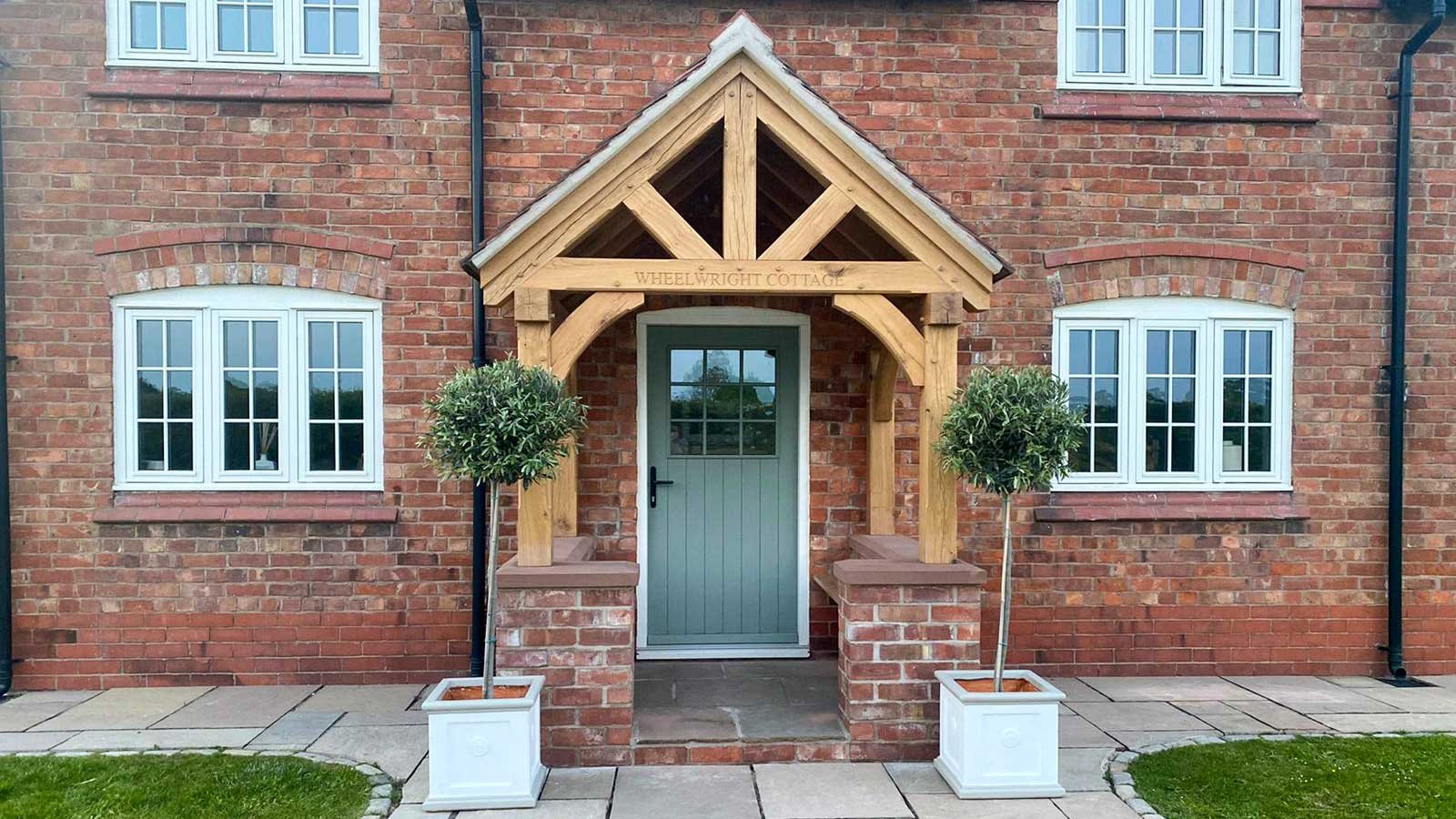
oakbydesign
01423 593 794


Gemma contacted Oak by Design in November after seeing an open oak porch they had supplied to social media influencer, Lydia Millen, on her Instagram page.
At the time, they were in the process of buying a new home, a double fronted brick built house in Cheshire, and wanted an oak porch to replace the existing canopy already on the front of the house.
Gemma thought Lydia’s was the style she wanted but once she started looking at the rest of the porches on the website and Instagram, she fell in love with a few!
The house they were buying had truss detailing above the upstairs windows, with an upright and 2 diagonal braces. Gemma wanted to replicate this on the porch’s truss. She also knew if she could fit in 2 porch seats, these would be a ‘must have’.
After working out what she wanted she showed husband Danny the photo’s and he just replied with ‘Wow’, so everyone was happy!
Their initial thoughts were to have a porch 2100mm wide x 2000mm deep. After looking at the porches that Gemma liked, Joanne suggested that they look at the Oak by Design website Case Studies. Looking at the sizes shown on the porches that Gemma liked, they were all less than 2 metres.
Eventually, after much agonising about size and design, they agreed the final drawing at 1600mm deep and 1940mm wide. She chose 2 curved brackets on the front of the porch and 2 curved brackets on each side.
The house purchase finally went through in Mid March, and once they knew the house was theirs, they paid their deposit and ordered the porch.
Although they owned the house, they had to have approval for any alterations from the Estate that their property had originally belonged to, to ensure that everything was in keeping with the area.
A 2D drawing was sent to the Estate for approval by them. They agreed with the porch in principle but were quite specific about the truss detail, which needed tweaking to have a 45° angle, and then finally approved!
Gemma’s builder came and put the footings in and built the dwarf wall, which he finished at 800mm high.
Gemma and Danny came to collect the porch at the end of April with Gemma’s parents horse-box! Gemma’s parents run Rackery Retreat a luxury glamping and wedding venue on the North Wales border near Chester.
Within a couple of days their builder had installed the porch and were ready for a post lockdown gathering for family.
John Burton supplied the coping-stones and Gemma recommends him for any stone supplies nationwide.
"Everyone has been watching the porch progress with interest" said Gemma, "it was nearly causing crashes with cars stopping to look!".
Building an oak porch is a significant investment that requires careful consideration and planning. This article will discuss three key factors to consider when embarking on such a project: architectural compatibility, planning permission requirements, and maintenance considerations.
One crucial factor to consider when building an oak porch is its architectural compatibility with your existing home. It is essential to ensure that the design of the porch harmonises with the overall style and aesthetics of your property. This can be achieved by selecting materials, finishes, and detailing that complement the existing architecture. By doing so, you create a cohesive and visually appealing structure that adds value to your home.
Before commencing any construction work on your oak porch, it is vital to research and understand the planning permission requirements in your area. Different regions have varying regulations regarding the size, height, and location of porches. Familiarise yourself with these guidelines to avoid potential legal issues or delays in your project. Engaging with local authorities or seeking professional advice can help you navigate through this process efficiently.
Lastly, it is crucial to consider the maintenance requirements associated with an oak porch. While oak is a durable material known for its longevity, regular maintenance is necessary to preserve its beauty and structural integrity. This may involve periodic cleaning, treatments such as oiling or staining, and occasional repairs if needed. Being aware of these maintenance tasks beforehand allows you to plan accordingly and ensure that your oak porch remains in optimal condition for years to come.
Green oak and air-dried oak are two distinct types of timber that differ in their characteristics. Understanding these differences is crucial for anyone involved in the construction or woodworking industry.
When comparing green oak to air-dried oak, one can draw an analogy with the concept of ageing wine. Just as wine needs time to mature and develop its unique flavours, green oak requires a seasoning process to achieve optimal quality.
During the seasoning process, green oak gradually loses moisture content through natural drying methods. This reduction in moisture not only improves the stability of the wood but also prevents excessive movement and shrinkage over time. It is comparable to how ageing wine develops complexity while maintaining stability.
On the other hand, air-dried oak undergoes a different drying method. Once cut into sizeable timber pieces, it is left outside to dry naturally over an extended period. The exposure to open air allows for gradual moisture loss through evaporation, resulting in lower moisture content compared to green oak.
The metaphorical comparison between green oak and ageing wine helps illustrate how both processes require patience and time for desirable outcomes. Just as aged wine showcases its refined qualities after years of maturing, air-dried oak represents a stable and reliable material due to its prolonged seasoning period.
In summary, understanding the distinction between green oak and air-dried oak is essential when choosing timber for construction purposes. Whether opting for freshly felled or naturally dried wood, each has its advantages based on specific project requirements and desired characteristics.
Telephone: 01423 593 794
Locksley Park
Blind Lane
Tockwith
YORK YO26 7QJ
Opening Times:
Mon to Fri - 9.00am to 5.00pm
Bank Holidays - Closed
Christmas 2025- TBC
Oak By Design is the trading name of:
Oak By Design Ltd.
Reg Number: 04384416
VAT Number: 664 8012 33